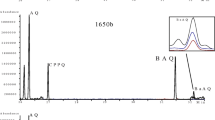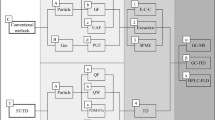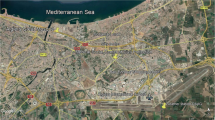Abstract
A headspace solid-phase microextraction (HS-SPME) procedure that employs a PDMS/DVB fiber was developed for the analysis of gas-phase polycyclic aromatic hydrocarbons (PAHs) collected in polyurethane foam (PUF) by gas chromatography (GC) mass spectrometry. The method exhibited good linearity (R 2 > 0.99) and repeatability (4.9–25 %) as well as an impressive detection limit that ranged from 1.1 to 3.3 ng. Twenty-two air samples were collected by high-volume samplers from January to November 2007 in a semiurban area of Dourados (Brazil) and were analyzed for their content of total suspended particulates and PAHs. The PAHs were extracted from the PUF samples using the developed procedure (HS-SPME), and PAHs adsorbed on particulate matter were extracted with dichloromethane/methanol (4:1 [v/v]) in an ultrasonic bath. The values of the total daily concentrations of 16 PAHs determined in the samples ranged from 0.375 to 8.407 ng m−3. In addition, diagnostic ratios were calculated, showing that the PAHs in the atmosphere at the sampling site originated predominantly from vehicle emissions and the combustion of grass and wood. Hierarchical cluster analysis and principal component analysis were performed as well, the results of which indicated (1) the same sources of PAH identified by the diagnostic ratios and (2) that the sampling days could be categorized into three groups depending on the atmospheric conditions. GC retention indices were also used to identify PAHs, biphenyl (phenylbenzene), and heterocyclic organic compounds (benzofurans) in some of the samples.



Similar content being viewed by others
References
Akyüz M, Çabuk H (2010) Gas-particle portioning and seasonal variation of polycyclic aromatic hydrocarbons in the atmosphere of Zonguldak, Turkey. Sci Total Environ 15:5550–5558
Alebic-Juretic A (2015) Airbone polycyclic aromatic hydrocarbons in suspended particulates from the urban atmosphere from the urban atmosphere of Rijeta, Croatia. Polycycl Aromat Compd 35:91–101
Alvarez-Avilés Q, Cuadra-Rodríguez L, González-Illán F, Quiñones-González J, Rosario O (2007) Optimization of a novel method for the organic chemical characterization of atmospheric aerosols based on microwave-assisted extraction combined with stir bar sorptive extraction. Anal Chim Acta 597:273–281
Arthur CL, Pawliszyn J (1990) Solid-phase microextraction with thermal desorption using fused silica optical fibers. Anal Chem 62:2145–2148
Aydin YM, Kara M, Dumanoglu Y, Odabasi M, Elbir T (2014) Source apportionment of polycyclic aromatic hydrocarbons (PAHs) and polychlorinated biphenyls (PCBs) in ambient air of an industrial region in Turkey. Atmos Environ 97:271–285
Azevedo DA, Moreira LS, Siqueira DS (1999) Composition of extractable organic matter in aerosols from urban areas of Rio de Janeiro city, Brazil. Atmos Environ 33:4987–5001
Budzinski H, Radke M, Garrigues P, Wise SA, Bellocq J, Willsch H (1992) Gas chromatographic retention behaviour of alkylated phenanthrenes on a smectic liquid crystalline phase: application to organic geochemistry. J Chromatogr A 627:227–239
Bundt J, Herbel W, Steinhart H, Franke S, Francke W (1991) Structure-type separation of diesel fuels by solid phase extraction and identification of the two- and three-ring aromatics by capillary GC-mass spectrometry. J High Res Chromatogr 14:91–98
Callén MS, López JM, Iturmendi A, Mastral AM (2013) Nature and sources of particle associated polycyclic aromatic hydrocarbons (PAH) in the atmospheric environment of an urban area. Environ Pollut 183:166–174
Chen Y, Cao J, Zhao J, Xu H, Arimoto R, Wang G et al (2014) n-Alkanes and polycyclic aromatic hydrocarbons in total suspended particulates from the southeastern Tibetan Plateau: concentrations, seasonal variations, and sources. Sci Total Environ 470–471:9–18. doi:10.1016/j.scitotenv.2013.09.033
Cincinelli A, Bubba MD, Martellini T, Gambaro A, Lepri L (2007) Gas-particle concentration and distribution of n-alkanes and polycyclic aromatic hydrocarbons in the atmosphere of Prato (Italy). Chemosphere 68:472–478
Coelho E, Ferreira C, Almeida CMM (2008) Analysis of polynuclear aromatic hydrocarbons by SPME–GC–FID in environmental and tap waters. J Braz Chem Soc 19:1084–1097
Companhia Nacional de Abastecimento (2012) Acompanhamento de safra brasileira: Cana-de- açúcar safra 2010/2011, primeiro levantamento, abril e 2010. CONAB, Brasília
Dallarosa JB, Mônego JG, Teixeira EC, Stefens JL, Wiegand F (2005) Polycyclic aromatic hydrocarbons in atmospheric particles in the metropolitan area of Porto Alegre, Brazil. Atmos Environ 39:1609–1625
Elias VO, Simoneit BRT, Cordeiro RC, Turcq B (2001) Evaluating levoglucosan as an indicator of biomass burning in Carajás, Amazônia: a comparison to the charcoal record. Geochim Cosmochim Acta 65(2):267–272
Fujiwara F, Guiñez M, Cerutti S, Smicho P (2014) UHPLC-(+)APCI-MS/MS determination of oxygenated and nitrated polycyclic aromatic hydrocarbons in airborne particulate matter and tree barks collected in Buenos Aires city. Microchem J 116:118–124
Gil-Molto J, Varea JM, Galindo N, Crespo J (2009) Application of an automatic thermal desorption-gas chromatography-mass spectrometry system for the analysis of polycyclic aromatic hydrocarbons in airborne particulate matter. J Chromatogr A 1216:1285–1289
Guilén MD, Iglesias MJ, Dominguez A, Blanco CG (1992) Polynuclear aromatic hydrocarbon retention indices on SE-54 stationary phase of the volatile components of a coal tar pitch: relationships between chromatographic retention and thermal reactivity. J Chromatogr A 591:287–295
Gupta S, Kumar K, Srivastava A, Srivastava A, Jain VK (2011) Size distribution and source apportionment of polycyclic aromatic hydrocarbons (PAHs) in aerosol particle samples from the atmospheric environment of Delhi, India. Sci Total Environ 409:4674–4680
He J, Fan S, Meng Q, Sun Y, Zhang J, Zu F (2014) Polycyclic aromatic hydrocarbons (PAHs) associated with fine particulate matters in Nanjing, China: distributions, sources and meteorological influences. Atmos Environ 89:207–215
International Agency for Research on Cancer (1984) Monographs on the evaluation of the carcinogenicity of chemicals to humans. In: Polynuclear aromatic compounds, part 3: industrial exposures in aluminum production, coal gasification, coke production, and iron and steel founding, vol 34. IARC, Lyon, France
Karthikeyan S, Balasubramanian R, See SW (2006) Optimization and validation of a low temperature microwave-assisted extraction method for analysis of polycyclic aromatic hydrocarbons in airborne particulate matter. Talanta 69:79–86
Katsoyiannis A, Terzi E, Cai QY (2007) On the use of PAH molecular diagnostic ratios in sewage sludge for the understanding of the PAH sources. Is this use appropriate? Chemosphere 69:1337–1339
Katsoyiannis A, Sweetman AS, Jones KC (2011) PAH molecular diagnostic ratios applied to atmospheric sources: a critical evaluation using two decades of source inventory and air concentration data from the UK. Environ Sci Technol 45:8897–8906
Khalili NR, Schefft PA, Holsen TM (1995) PAH source fingerprints for coke ovens, diesel and gasoline engines, highway tunnels, and wood combustion emissions. Atmos Environ 29(5):33–542
Kishida M, Nishikawa A, Fujimori K, Shibutani Y (2011) Gas–particle concentrations of atmospheric polycyclic aromatic hydrocarbons at an urban and a residential site in Osaka, Japan: effect of the formation of atmospherically stable layer on their temporal change. J Hazard Mater 192:1340–1349
Koziel JA, Odziemkowski M, Pawliszyn J (2001) Sampling and analysis of airborne particulate matter and aerosols using in-needle trap and SPME fiber devices. Anal Chem 73:47–54
Krugly E, Martuzevicius D, Sidaraviciute R, Ciuzas D, Prasauskas T, Kauneliene V et al (2014) Characterization of particulate and vapor phase polycyclic aromatic hydrocarbons in indoor and outdoor air of primary schools. Atmos Environ 82:298–306
Kulkarni P, Venkataraman C (2000) Atmospheric polycyclic aromatic hydrocarbons in Mumbai, India. Atmos Environ 34:2785–2790
Kwok ESC, Harger WPL, Arey J, Atkinson R (1994) Reactions of gas-phase phenanthrene under simulated atmospheric conditions. Environ Sci Technol 28:521–527
Lai IC, Lee CL, Zeng KY, Huang HC (2011) Seasonal variation of atmospheric polycyclic aromatic hydrocarbons along the Kaohsiung coast. J Environ Manag 92:2029–2037
Lai IC, Chang YC, Lee CL, Chiou GY, Huang HC (2013) Source identification and characterization of atmospheric polycyclic aromatic hydrocarbons along the southwestern coastal area of Taiwan—with a GMDH approach. J Environ Manag 115:60–68
Lammel G, Klánová J, Ilic P, Kohoutek J, Gasi B, Kovaci I et al (2010) Polycyclic aromatic hydrocarbons in air on small spatial and temporal scales—II. Mass size distributions and gas-particle partitioning. Atmos Environ 44:5022–5027
Latif MT, Meia CS, Hanif MN, Srithawiratc T (2012) Levoglucosan as an indicator of biomass burning from selected tropical plants. Environ Asia 5:22–27
Lee ML, Vassilaros DL, White CM, Novotny M (1979) Retention indices for programmed-temperature capillary-column gas chromatography of polycyclic aromatic hydrocarbons. Anal Chem 51:768–773
Lee RGM, Coleman P, Jones JL, Jones KC, Lohmann R (2005) Emission factors and importance of PCDD/Fs, PCBs, PCNs, PAHs and PM10 from the domestic burning of coal and wood in the UK. Environ Sci Technol 39:1436–1447
Lin Y, Qiu X, Ma Y, Ma J, Zheng M, Shao M (2015) Concentrations and spatial distribution of polycyclic aromatic hydrocarbons (PAHs) and nitrated PAHs (NPAHs) in the atmosphere of North China, and the transformation from PAHs to NPAHs. Environ Pollut 196:164–170
Marr LC, Dzepina K, Jimenez JL, Riesen F, Bethel HL, Arey J et al (2006) Sources and transformations of particle-bound polycyclic aromatic hydrocarbons in Mexico City. Atmos Chem Phys 6:1733–1745
Marynowski L, Kubik R, Uhl D, Simoneit BRT (2014) Molecular composition of fossil charcoal and relationship with incomplete combustion of wood. Org Geochem 77:22–31
Menezes HC, Cardeal ZL (2011) Determination of polycyclic aromatic hydrocarbons from ambient air particulate matter using a cold fiber solid phase microextraction gas chromatography–mass spectrometry method. J Chromatogr A 1218:3300–3330
Oros DR, Abas MRB, Osmar NYMJ, Rahman NA, Simoneit BRT (2006) Identification and emission factors of molecular tracers in organic aerosols from biomass burning: part 3. Grasses. Appl Geochem 21:919–940
Pandey SK, Ki-H Kim, Brown RJC (2011) A review of techniques for the determination of polycyclic aromatic hydrocarbons in air. Trends Anal Chem 30(11):1716–1739
Paschke A, Herbel W, Steinhart H, Franke S, Francke W (1992) Determination of mono-to tetracyclic aromatic hydrocarbons in lubricating oil. J High Res Chromatogr 15:827–833
Ré-Poppi N, Santiago-Silva MR (2002) Identification of polycyclic aromatic hydrocarbons and methoxylated phenols in wood smoke emitted during production of charcoal. Chromatographia 55:475–481
Ré-Poppi N, Santiago-Silva M (2005) Polycyclic aromatic hydrocarbons and other selected organic compounds in ambient air of Campo Grande City, Brazil. Atmos Environ 39:2839–2850
Rynö M, Rantanen L, Papaioannou E, Konstandopoulos AG, Koskentalo T, Savela K (2006) Comparison of pressurized fluid extraction, Soxhlet extraction and sonication for the determination of polycyclic aromatic hydrocarbons in urban air and diesel exhaust particulate matter. J Environ Monit 8(4):488–493
Saxena M, Singh DP, Saud T, Gadi R, Singh S, Sharma SK et al (2014) Study on particulate polycyclic aromatic hydrocarbons during Bay of Bengal in winter season. Atmos Res 145–146:205–213
Shen G, Tao S, Wei S, Zhang Y, Wang R, Wang B et al (2012) Retene emission from residential solid fuels in China and evaluation of retene as a unique marker for soft wood combustion. Environ Sci Technol 46:4666–4672
Shimmo M, Anttila P, Hartonen K, Hyötyläinen T, Paatero J, Kulmala M et al (2004) Identification of organic compounds in atmospheric aerosol particles by on-line supercritical fluid extraction–liquid chromatography–gas chromatography–mass spectrometry. J Chromatogr A 1022:151–159
Simoneit BRT (2002) Biomass burning—a review of organic tracers for smoke from incomplete combustion. Appl Geochem 17:129–162
Sofowote UM, Hung H, Rastogi AK, Westgate JN, Su Y, Sverko E et al (2010) The gas/particle partitioning of polycyclic aromatic hydrocarbons collected at a sub-Arctic site in Canada. Atmos Environ 44:4919–4926
Souza KF, Carvalho LRF, Allen AG, Cardoso AA (2014) Diurnal and nocturnal measurements of PAH, nitro PAH, and oxy-PAH compounds in atmospheric particulate matter of a sugar cane burning region. Atmos Environ 83:193–201
Szulejko JE, Kim KH, Brown RJC, Bae MS (2014) Review of progress in solvent-extraction techniques for the determination of poly-aromatic hydrocarbons as airborne pollutants. Trends Anal Chem 61:40–48
Tang XL, Bi XH, Sheng GY, Tan JH, Fu JM (2006) Seasonal variation of the particle size distribution of n-alkanes and polycyclic aromatic hydrocarbons (PAHs) in urban aerosol of Guangzhou, China. Environ Monit Assess 117:193–213
Teixeira EC, Agudelo-Castañeda DM, Fachel JMG, Leal KA, Garcia KO, Wiegand F (2012) Source identification and seasonal variation of polycyclic aromatic hydrocarbons associated with atmospheric fine and coarse particles in the Metropolitan Area of Porto Alegre, RS, Brazil. Atmos Res 118:390–403
Thompson M, Ellison SLR, Wood R (2002) Harmonized guidelines for single-laboratory validation of methods of analysis (IUPAC technical report). Pure Appl Chem 74:835–855
Tobiszewski M, Namiésnik J (2012) PAH diagnostic ratios for the identification of pollution emission sources. Environ Pollut 162:110–119
Vandendool H, Kratz PD (1963) A generalization of retention index system including linear temperature programmed gas-liquid partition chromatography. J Chromatogr 11:463
Vassilaros DL, Kong RC, Later DW, Lee ML (1982) Linear retention index system for polycyclic aromatic compounds: critical evaluation and additional indices. J Chromatogr 252:1–20
Vaz JM (2003) Screening direct analysis of PAHS in atmospheric particulate matter with SPME. Talanta 60:687–693
Wauters E, Peter Van Caeter PV, Desmet G, David F, Devos C, Sandra P (2008) Improved accuracy in the determination of polycyclic aromatic hydrocarbons in air using 24 h sampling on a mixed bed followed by thermal desorption capillary gas chromatography–mass spectrometry. J Chromatogr A 1190:286–293
Wei MC, Chang WT, Jen JF (2007) Monitoring of PAHs in air by collection on XAD-2 adsorbent then microwave-assisted thermal desorption coupled with headspace solid-phase microextraction and gas chromatography with mass spectrometric detection. Anal Bioanal Chem 387:999–1005
Wise SA, Benner BA, Byrd GD, Chesler SN, Rebbert RE, Schantz MM (1988) Determination of polycyclic aromatic hydrocarbons in a coal tar standard reference material. Anal Chem 60:887–894
World Health Organization (1987) Polynuclear aromatic hydrocarbons (PAH). In: Air quality guidelines for Europe. WHO Office for Europe, Copenhagen, Denmark, pp 105–117
Yunker MB, Macdonald RW, Vingarzan R, Mitchell RH, Goyette D, Sylvestre S (2002) PAHs in the Fraser River basin: a critical appraisal of PAH ratios as indicators of PAH source and composition. Org Geochem 33:489–515
Acknowledgments
The authors gratefully acknowledge financial support for this research provided by Fundação de Apoio ao Desenvolvimento do Ensino, Ciência e Tecnologia do Estado de Mato Grosso do Sul and Conselho Nacional de Desenvolvimento Científico e Tecnológico.
Author information
Authors and Affiliations
Corresponding author
Electronic supplementary material
Below is the link to the electronic supplementary material.
Rights and permissions
About this article
Cite this article
Ré, N., Kataoka, V.M.F., Cardoso, C.A.L. et al. Polycyclic Aromatic Hydrocarbon Concentrations in Gas and Particle Phases and Source Determination in Atmospheric Samples from a Semiurban Area of Dourados, Brazil. Arch Environ Contam Toxicol 69, 69–80 (2015). https://doi.org/10.1007/s00244-015-0153-8
Received:
Accepted:
Published:
Issue Date:
DOI: https://doi.org/10.1007/s00244-015-0153-8




